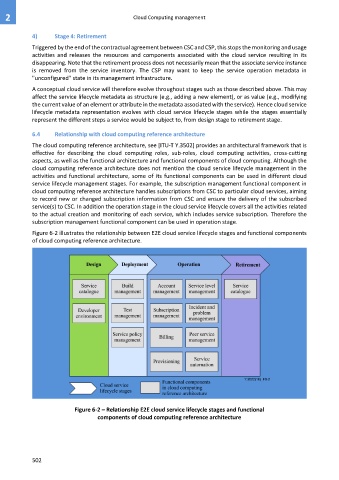Page 510 - Cloud computing: From paradigm to operation
P. 510
2 Cloud Computing management
4) Stage 4: Retirement
Triggered by the end of the contractual agreement between CSC and CSP, this stops the monitoring and usage
activities and releases the resources and components associated with the cloud service resulting in its
disappearing. Note that the retirement process does not necessarily mean that the associate service instance
is removed from the service inventory. The CSP may want to keep the service operation metadata in
"unconfigured" state in its management infrastructure.
A conceptual cloud service will therefore evolve throughout stages such as those described above. This may
affect the service lifecycle metadata as structure (e.g., adding a new element), or as value (e.g., modifying
the current value of an element or attribute in the metadata associated with the service). Hence cloud service
lifecycle metadata representation evolves with cloud service lifecycle stages while the stages essentially
represent the different steps a service would be subject to, from design stage to retirement stage.
6.4 Relationship with cloud computing reference architecture
The cloud computing reference architecture, see [ITU-T Y.3502] provides an architectural framework that is
effective for describing the cloud computing roles, sub-roles, cloud computing activities, cross-cutting
aspects, as well as the functional architecture and functional components of cloud computing. Although the
cloud computing reference architecture does not mention the cloud service lifecycle management in the
activities and functional architecture, some of its functional components can be used in different cloud
service lifecycle management stages. For example, the subscription management functional component in
cloud computing reference architecture handles subscriptions from CSC to particular cloud services, aiming
to record new or changed subscription information from CSC and ensure the delivery of the subscribed
service(s) to CSC. In addition the operation stage in the cloud service lifecycle covers all the activities related
to the actual creation and monitoring of each service, which includes service subscription. Therefore the
subscription management functional component can be used in operation stage.
Figure 6-2 illustrates the relationship between E2E cloud service lifecycle stages and functional components
of cloud computing reference architecture.
Figure 6-2 – Relationship E2E cloud service lifecycle stages and functional
components of cloud computing reference architecture
502

